Related Research Articles

Looney Tunes is an American animated franchise produced and distributed by Warner Bros. It began as a series of short films that originally ran from 1930 to 1969, concurrently with its partner series Merrie Melodies, during the golden age of American animation. Following a revival in the late 1970s, new shorts were released as recently as 2014. The two series introduced a large cast of characters, including Bugs Bunny, Daffy Duck, and Porky Pig. The term Looney Tunes has since been expanded to also refer to the characters themselves.

Daffy Duck is a fictional character created by animators Tex Avery and Bob Clampett for Leon Schlesinger Productions. Styled as an anthropomorphic black duck, he has appeared in cartoon series such as Looney Tunes and Merrie Melodies, in which he is usually depicted as a foil for either Bugs Bunny, Porky Pig or Speedy Gonzales. He was one of the first of the new "screwball" characters that emerged in the late 1930s to replace traditional everyman characters who were more popular earlier in the decade, such as Mickey Mouse, Porky Pig, and Popeye.

Robert Emerson Clampett Sr. was an American animator, director, producer and puppeteer best known for his work on the Looney Tunes animated series from Warner Bros. as well as the television shows Time for Beany and Beany and Cecil. He was born and raised not far from Hollywood and, early in life, showed an interest in animation and puppetry. After dropping out of high school in 1931, he joined the team at Harman-Ising Productions and began working on the studio's newest short subjects, Looney Tunes and Merrie Melodies.

Merrie Melodies is an American animated comedy short film series distributed by Warner Bros. Pictures. It is the companion series to Looney Tunes, and featured many of the same characters. It originally ran from August 2, 1931, to September 20, 1969, during the golden age of American animation, though it was revived in 1979, with new shorts sporadically released until June 13, 1997. Originally, Merrie Melodies placed emphasis on one-shot color films in comparison to the black-and-white Looney Tunes films. After Bugs Bunny became the breakout character of Merrie Melodies and Looney Tunes transitioned to color production in the early 1940s, the two series gradually lost their distinctions and shorts were assigned to each series randomly.
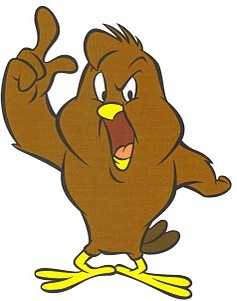
Henery Hawk is an American cartoon character who appears in twelve comedy film shorts produced in the Looney Tunes and Merrie Melodies series. His first appearance is in the 1942 theatrical release The Squawkin' Hawk, which was directed by Chuck Jones and produced by Leon Schlesinger. Henery's second screen appearance, one directed by Robert McKimson, is in Walky Talky Hawky (1946), which also features the characters Foghorn Leghorn and Barnyard Dawg in their first cartoon roles. The last Warner Brothers theatrical short to showcase the little chickenhawk is the 1961 release Strangled Eggs in which he co-stars again with Foghorn Leghorn as well as with another popular character of that period, Miss Prissy. Following that production, Henery continued to be seen periodically in other animated presentations such as The Looney Tunes Show and Looney Tunes Cartoons.
"The Merry-Go-Round Broke Down" is a song written in 1937 by Cliff Friend and Dave Franklin and published by Harms Inc., New York. It is best known as the theme tune for the Looney Tunes cartoon series and Merrie Melodies reissued cartoon series produced by Warner Bros. Cartoons, used from 1937 to 1969.

Daffy Duck & Egghead is a 1938 Warner Bros. Merrie Melodies cartoon produced in 1937 and directed by Tex Avery. The cartoon was released on January 1, 1938, and stars Daffy Duck and Egghead.

Walky Talky Hawky is a 1946 Warner Bros. Merrie Melodies theatrical short directed by Robert McKimson. The cartoon was released on August 31, 1946, and features Henery Hawk and Foghorn Leghorn. This is the first appearance of both Foghorn Leghorn and the Barnyard Dawg.

Porky's Poultry Plant is a 1936 Warner Bros. Looney Tunes cartoon directed by Frank Tashlin and composed by Carl Stalling. The short was released on August 22, 1936, and stars Porky Pig.
Porky's Spring Planting is a 1938 Warner Bros. Looney Tunes cartoon directed by Frank Tashlin. The short was released on July 25, 1938, and stars Porky Pig.

Milk and Money is a 1936 Warner Bros. Looney Tunes animated short film directed by Tex Avery. The short was released on October 3, 1936, and stars Porky Pig.

Swooner Crooner is a 1944 Warner Bros. Looney Tunes cartoon directed by Frank Tashlin. The short was released on May 6, 1944, and stars Porky Pig.
The Goofy Gophers is a 1947 Warner Bros. Looney Tunes cartoon directed by Bob Clampett and Arthur Davis. The short was released on January 25, 1947, and is the first appearance of the Goofy Gophers.
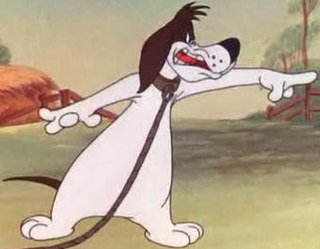
Barnyard Dawg is a Looney Tunes character. A feisty anthropomorphic basset hound, he is a friend and the archenemy of Foghorn Leghorn. He was created by Robert McKimson, who also created Foghorn, and was voiced by Mel Blanc. Dawg also feuds with other enemies as well like Henery Hawk, Daffy Duck and Sylvester. He appeared in 23 Golden Age–era Warner Bros. shorts.
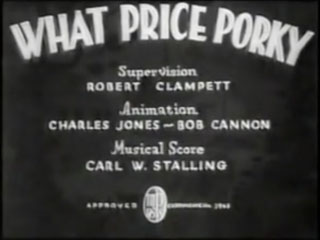
What Price Porky is a 1938 Warner Bros. Looney Tunes cartoon directed by Bob Clampett. The cartoon was released on February 26, 1938, and stars Porky Pig and Daffy Duck.

The Looney Tunes Show is an American animated sitcom produced by Warner Bros. Animation, and aired on Cartoon Network for two seasons from May 3, 2011, to November 2, 2013. The series differed from others featuring characters from the Looney Tunes, by focusing on stories conformed around a sitcom format involving the characters of Bugs Bunny and Daffy Duck, who live a surburban life together within a neighborhood of fellow cartoon neighbors, dealing with various issues in their own way. Both the characters from the Looney Tunes, as well as the Merrie Melodies theatrical cartoon shorts, were given a 21st century update, with episodes also including a musical short; the first series also included computer-animated shorts involving new antics between Wile E. Coyote and the Road Runner.
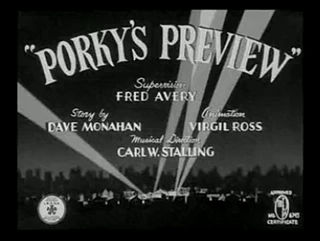
Porky's Preview is a Warner Bros. Looney Tunes cartoon directed by Tex Avery. The short was released on April 19, 1941, and stars Porky Pig.
Porky's Bear Facts is a 1941 Warner Bros. Looney Tunes cartoon animated short directed by Friz Freleng. The short was released on March 29, 1941, and stars Porky Pig. The voices were performed by Mel Blanc.

Looney Tunes: Rabbits Run is a 2015 American animated direct-to-video adventure comedy film in the Looney Tunes franchise produced by Warner Bros. Animation. It is the first new Looney Tunes direct-to-video film since Bah, Humduck! A Looney Tunes Christmas was released nine years prior. The film was made shortly after The Looney Tunes Show, and shares much of the same crew as that series, including director Jeff Siergey, who had also been a supervising animator on Space Jam and lead animator on Looney Tunes: Back in Action. It was released on August 4, 2015, by Warner Bros. Discovery Home Entertainment, but it was released early on July 7, 2015 on Vudu and Walmart.
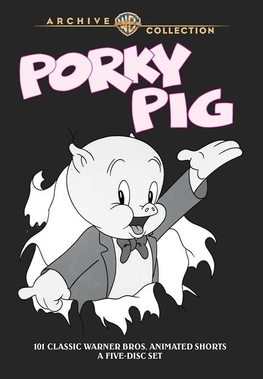
Porky Pig 101 is a DVD box-set released by Warner Archive Collection, collecting the first 101 animated short subjects starring the Looney Tunes and Merrie Melodies character Porky Pig. The set features all 99 Porky Pig cartoons made in black and white, as well as two cartoons made in color: Porky's debut appearance in I Haven't Got a Hat (1935) and the color "special" Old Glory (1939).
References
- ↑ Scott, Keith (3 October 2022). Cartoon Voices of the Golden Age, Vol. 2. BearManor Media. p. 55.
- ↑ MUBI
- ↑ Beck, Jerry; Friedwald, Will (1989). Looney Tunes and Merrie Melodies: A Complete Illustrated Guide to the Warner Bros. Cartoons. Henry Holt and Co. p. 61. ISBN 0-8050-0894-2.
- ↑ Lenburg, Jeff (1999). The Encyclopedia of Animated Cartoons. Checkmark Books. pp. 124–126. ISBN 0-8160-3831-7 . Retrieved 6 June 2020.
- ↑ Elmer Wait-IMDB
- ↑ Porky's Garden (Redrawn)-Internet Archive